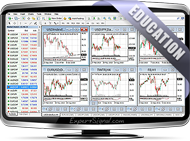Understanding the Full Set of Trading Orders

Selecting and placing the right trading orders can make all the difference when manually trading any financial market.
Why Does the Availability of a Full Set of Trading Orders Matter?
The variety of trading orders available on modern platforms is essential for meeting diverse trading needs. Here are some key advantages of using a full set of trading orders:
→ Apply effective money management
→ Adapt to any market conditions (limit orders)
→ Minimize loss potential and protect your account (stop-loss orders)
→ Lock in and protect profits (trailing take-profit orders)
→ Time trades effectively (GTC, GFD orders)
→ Trade short-term price fluctuations (from entry to exit)
→ Implement multidimensional strategies (OCO orders)
Trading Order Types
These are the main types of trading orders used in Forex, CFDs, and Futures trading.
(i) Market Orders
A market order (Buy/Sell) is executed at the current market price (Bid/Ask). It includes only one variable: quantity. The advantage of this order type is instant execution.
Tip: Avoid placing market orders in illiquid markets, especially before market openings. Additionally, during key news releases, traders should exercise caution when placing market orders—particularly if their broker uses a Dealing Desk (Market Maker). During news events, the spread between ask/bid often widens significantly, and slippage from market makers can make execution more costly.
Why Is a Market Order Important?
A market order is filled instantly, which is crucial for event-driven strategies such as news trading.
(ii) Limit Orders
A limit order (Buy/Sell) is filled at a specific, pre-determined price. It includes two more variables than a market order: price and duration. Traders can specify how long the limit order remains active.
Why Is a Limit Order Important?
A limit order provides extended control and safety for all trading styles.
(iii) Stop Orders
(a) Stop-Loss Orders
A stop-loss order is set at a specific price. If the market reaches that price, the position closes automatically. This order aims to limit the potential loss of a trade.
Tip: After the market closes (e.g., Friday midnight for currencies), a stop-loss may not protect your account. Markets often reopen with price gaps, meaning a stop-loss cannot guarantee the extent of a loss.
(b) Take-Profit Orders
A take-profit order is placed at a certain price, and if reached, the position closes automatically. This order is used to lock in potential profits. Advanced traders often use trailing take-profit orders.
(iv) Trailing Stop Orders
A trailing stop order is a dynamic stop order that closes a position if the market moves unfavorably. It adapts to market conditions, offering more flexibility than a standard stop order. Traders can set it at a fixed number of pips from the entry rate (e.g., 7 or 9 pips), and it will adjust automatically as the market moves.
Why Is a Trailing Stop Order Important?
This order offers greater flexibility in maximizing profits while limiting risk.
(v) GTC Orders (Good Till Cancelled)
This type of trading order remains active until the trader cancels it. Therefore, a GTC order will either be filled by the market or canceled manually by the trader.
Why Is a GTC Order Important?
It can save time, especially for traders who place the same orders every morning.
(vi) GFD Orders (Good For the Day)
A GFD order remains active until the end of the trading day. Since Forex is a 24-hour market, the end of the day is determined by the broker’s server time. For UK-based brokers, the day ends at 00:00 GMT; for Cyprus-based brokers, at 00:00 GMT+2.
(vii) OCO (Order Cancels Other)
An OCO order combines two different orders. When one order is filled, the other is canceled automatically.
Why Is an OCO Order Important?
OCO orders are placed above and below the current market level, enabling the implementation of multi-dimensional trading strategies. For example, when the price reaches a key support/resistance level, an OCO order can capture both the potential breakout and the possible reversal.
□ Types of Trading Orders
ExpertSignal.com




